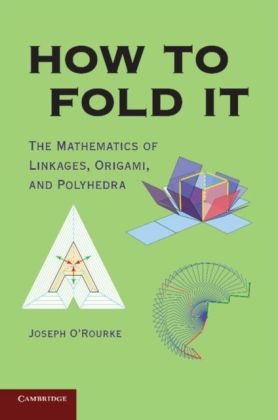
How to Fold It
Cambridge University Press (Verlag)
978-0-521-14547-3 (ISBN)
What do proteins and pop-up cards have in common? How is opening a grocery bag different from opening a gift box? How can you cut out the letters for a whole word all at once with one straight scissors cut? How many ways are there to flatten a cube? With the help of 200 colour figures, author Joseph O'Rourke explains these fascinating folding problems starting from high school algebra and geometry and introducing more advanced concepts in tangible contexts as they arise. He shows how variations on these basic problems lead directly to the frontiers of current mathematical research and offers ten accessible unsolved problems for the enterprising reader. Before tackling these, you can test your skills on fifty exercises with complete solutions. The book's website, http://www.howtofoldit.org, has dynamic animations of many of the foldings and downloadable templates for readers to fold or cut out.
Joseph O'Rourke is Professor and Chair of the Computer Science Department, a Professor of Mathematics, and Director of Arts and Technology at Smith College. His research is in computational geometry, developing algorithms for geometric computations. He has won several awards, including a Guggenheim Fellowship in 1987 and the NSF Director's Award for Distinguished Teaching Scholars in 2001. He has published more than 145 papers in journals and conference proceedings, more than 30 of which were coauthored with undergraduates. He has taught folding and unfolding to students in grade school, middle school, high school, college and graduate school, and to teachers - of grade school, middle school, and high school - professors, and researchers. This is his sixth book.
Part I. Linkages: 1. Robot arms; 2. Straight-line linkages and the pantograph; 3. Protein folding and pop-up cards; Part II. Origami: 4. Flat vertex folds; 5. Fold and one-cut; 6. The shopping bag theorem; Part III. Polyhedra: 7. Durer's problem: edge unfolding; 8. Unfolding orthogonal polyhedra; 9. Folding polygons to convex polyhedra; 10. Further reading; 11. Glossary; 12. Answers to exercises; 13. Permissions and acknowledgments.
| Zusatzinfo | Worked examples or Exercises; 1 Tables, unspecified; 171 Plates, unspecified |
|---|---|
| Verlagsort | Cambridge |
| Sprache | englisch |
| Maße | 152 x 226 mm |
| Gewicht | 330 g |
| Themenwelt | Sachbuch/Ratgeber ► Natur / Technik |
| Mathematik / Informatik ► Mathematik ► Allgemeines / Lexika | |
| Mathematik / Informatik ► Mathematik ► Algebra | |
| Mathematik / Informatik ► Mathematik ► Geometrie / Topologie | |
| Mathematik / Informatik ► Mathematik ► Mathematische Spiele und Unterhaltung | |
| ISBN-10 | 0-521-14547-3 / 0521145473 |
| ISBN-13 | 978-0-521-14547-3 / 9780521145473 |
| Zustand | Neuware |
| Informationen gemäß Produktsicherheitsverordnung (GPSR) | |
| Haben Sie eine Frage zum Produkt? |
aus dem Bereich


